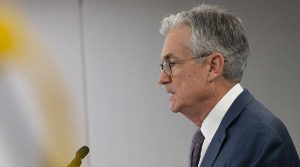MAY 16, 2020

Federal Reserve Chairman Jerome Powell shook markets and alarmed lawmakers this week with a dire warning: The U.S. could suffer through years of sluggish growth and meager job gains well after the pandemic passes without further economic stimulus.
In a speech Tuesday, Powell urged lawmakers to set aside concerns about the mounting national debt and provide the fiscal support necessary to keep the economy from spiraling deeper into the worst downturn since the Great Recession.
“Additional fiscal support could be costly, but worth it if it helps avoid long-term economic damage and leaves us with a stronger recovery. This trade-off is one for our elected representatives, who wield powers of taxation and spending,” said Powell, a Republican who had urged Congress to cut deficits shortly before COVID-19 roiled the global economy.
Powell’s comments came soon after White House officials and GOP leaders pumped the brakes on another fiscal stimulus package and declared a formal pause on negotiations even as the unemployment rate spiked to 14.7 percent and the U.S. lost 20.5 million jobs in April.
“We think we ought to take a pause here, do a good job of evaluating what we’ve already done,” said Senate Majority Leader Mitch McConnell (R-Ky.) last week, shooting down the prospect of further aid passing before the summer as House Democrats passed another $3 trillion rescue package on Friday.
Powell’s call this week for aggressive fiscal action was not his first since the coronavirus pandemic forced thousands of businesses to close and millions of Americans to lose their jobs. He urged lawmakers in a speech on April 29 to unleash the “great fiscal power” of the U.S. to defeat COVID-19, and has warned throughout the crisis the Fed’s unprecedented response alone would not save the economy.
“There is a growing sense that the recovery may come more slowly than we would like, but it will come. And that may mean that it’s necessary for us to do more,” Powell said during a webcast interview following his Tuesday remarks.
Powell is also the latest in a line of Fed chiefs – including his past two predecessors, Janet Yellen and Ben Bernanke – to nudge Congress toward spending more than it might be comfortable spending.
“He is really telling Congress, ‘Do not fall back on making monetary policy the only game in town’ because that’s not going to resolve this sort of terror in the economy,” said Sarah Binder, a political scientist at George Washington University and co-author of “The Myth of Independence: How Congress Governs the Federal Reserve.”
“In these types of crises, the central banks can’t solve them, and so it’s not unusual to see either some coordination or some cooperation,” she continued, even with the Fed’s already ambitious response.
Since March 15, the Fed has dropped its baseline interest range to just above zero, purchased more than $6 trillion in bonds and securities, and stood up nearly a dozen emergency lending facilities set to finance more than $2 trillion in aid.
Powell was among the first federal officials to express concerns with COVID-19’s potential economic threats to the U.S. as President Trump and his top aides initially appeared to brush off the rising danger. He told reporters during a January 29 press conference that the virus posed “very serious” economic challenges that could spread beyond China, where the virus is believed to have originated.
Less than a month later, Powell had spent a steadily increasing portion of each day meeting or speaking with fellow Fed board members, reserve bank presidents, U.S. and global financial regulators, Treasury Secretary Steven Mnuchin, counterparts at global central banks, professors, and lawmakers, according to his schedule released by the Fed, including three calls with Trump within two months.
By Friday Feb. 28, Powell’s schedule was filled with 10 to 12 hours of back-to-back phone calls and meetings as the stock market crashed shortly after the Centers for Disease Control and Prevention (CDC) warned of an “inevitable” U.S. outbreak. He issued a statement later that afternoon hinting toward a potential rate cut in between 18 meetings and phone calls over the course of that day.
After a weekend of growing panic in financial markets, Powell spent March 2 in almost 10 consecutive hours of phone calls and meetings, followed by an emergency summit of the bank’s policymaking arm, the Federal Open Market Committee.
The Fed announced an emergency 0.5 percentage point interest rate cut the following day, and dropped rates to a 0 to 0.25 percent range less than two weeks later on March 15. Powell began working out of his Maryland home the next day as states across the East coast implored residents to bunker down.
“These are real professionals.They’re not scientists, but they’re social scientists and they approach things that way. If there’s a chance of a crisis, you know they will be wargaming it out,” said New York University economics professor Mark Gertler, a frequent research partner of Bernanke. Gertler and five other prominent economists met with Powell and Fed staff in Washington on Feb. 25, roughly a week before the first March rate cut.
“I don’t know what the rules are, whether I can say what was said in that meeting,” Gertler responded when asked if the pandemic was discussed. “But I can say that they’re always planning ahead.”
The Fed’s swift response helped stabilize financial markets as the U.S. began to lock down and earned Powell near unanimous praise. Even Trump, who promoted Powell to the Fed chairmanship and floated firing him less than a year later, called him his “Most Improved Player” despite Powell’s fierce defense of its political independence.
“He has done a very good job over the last couple of months, I have to tell you that,” Trump told reporters during a meeting this week.
Powell’s next challenge is to convince fellow Republicans to overlook their ideological opposition to deficits and steer the country through a crisis.
Powell caught the attention of the Obama White House in 2011 when the future Fed chairman implored Republicans to raise the federal debt limit when he was a fellow at the Bipartisan Policy Center. Obama nominated Powell to the Fed alongside a stalled Democratic nominee, former Fed Governor Jeremy Stein, and broke the partisan logjam when the Senate confirmed both on May 2012.
Eight years later, Powell is again imploring Republicans to loosen the federal pursestrings for now and tackle the long-term challenge of the $24 trillion debt amid a partisan showdown with dire implications.
Democrats have seized on Powell’s comments to boost pressure on Republicans to approve more spending Speaker Nancy Pelosi (D-Calif.) echoed Powell on the House floor Friday ahead of the chamber’s passage of the latest $3-trillion coronavirus package, insisting that the costliest choice was inaction.
“We have the responsibility and the opportunity to think big, as he advised, and act now for the people,” Pelosi said.
And while McConnell has shot down any chance of passing the new Democratic measure, he acknowledged on Thursday that there was a “high likelihood” that Congress would need to pass another round of stimulus.
“I’m certainly not ruling out another fiscal package, and I would say the chairman of the Fed and I and the administration are not necessarily in different places,” he continued.
Courtesy/Source: The Hill










































































































